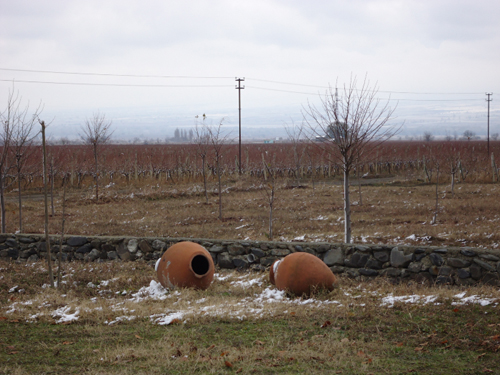
The traditional amber wines of Georgia
Jeremy Bowers in For the Love of Food
White wine is a regrettable modern amalgamation, unheard of until the tail end of the 19th century.
If you’re familiar with winemaking, perhaps you still have this scene in your head: Peasants picking baskets of grapes, throwing them one bushel at a time into a large, knee-high vat. Workers there press the grapes with their feet and the juice trickles out of a spigot and into a barrel where it can be fermented and then bottled.
The construction of a modern white wine bears zero resemblance to this vision. Grapes are typically mechanically picked, the juice separated from the skins, seeds and stems in gigantic hoppers, and then fermented in large stainless steel tanks — only after being filtered through microscopic filters that remove every impurity that might make this batch different from the last.
Winemakers of old didn’t have stainless steel tanks or microscopic filters. And pressing the juice and fermenting it alone, discarding the skins and stems? Why give up all of that flavor? That greenish-yellow miracle you’re sipping now is a purely modern construction, made available thanks to technologies that didn’t come around until the late 1800s.
If you’d like to drink white wines like an archaeologist, you shouldn’t look for white wine — you should look for orange.
Thankfully, a few winemakers are still making wines in the traditional fashion. In northern Italy, parts of France, Slovenia, Armenia, Croatia and Georgia, methods thousands of years old produce a cloudy, amber liquid that to modern palates actually indicate fault.
In particular, the Georgian winemaking style merits further study. The regional favorite grape, Rkatsiteli (er-KATSEH-telly), favors the process of fermentation on the skins. Georgian winemakers still ferment the pressed grapes on the skins, seeds and stems, buried underground in clay amphorae called quevri.
The grapes are allowed to ferment on the skins for an extended period of time, sometimes as long as several months — almost exactly like a red wine. In fact, orange wines can most easily be described as white wines made in the manner of a red wine.
During this period of fermentation on the skins, interesting things happen to an orange wine that your grassy Pinot grigio never experiences. Chemical compounds slowly leach out of the skins — phenols and color compounds.
The most easily identified phenolic compound in wine are tannins — the dry feeling on your tongue that you get when you drink an earthy Italian or French red. Tannins react to the protein in your saliva, which is why you notice astringency when it first touches your tongue. A standard white wine — Sauvignon blanc or Pinot grigio — have so few tannins that they’re undetectable. Not so for Rkatsiteli. With your eyes closed, you could easily mistake it for a medium-bodied, dry red.
Other phenols leaking into your orange wine include anthocyanins, which give the wine its distinctive amber-orange hue, and flavanoids like resveratrol, which might be the answer to the French paradox.
Modern producers tend to filter, fine and stabilize the wines before bottling. Filtering removes yeasts and other molecular bits left over from the fermentation process. Fining uses chemicals to attach to and remove phenolic compounds, proteins and yeasts. And stabilization removes deposits like tartaric acid that might make the wine less resistant to changes in temperature or movement.
Unfortunately, these processes which make wines finer, clearer and more resistant to shipping also remove many of the compounds which give a wine character. Rkatsiteli, you’ll notice, is a bit cloudy — that sediment is bits of yeasts and proteins that give the wine its tart and funk. And since phenols can make a wine vary from batch to batch, these are often removed as well. It’s basically a wine lobotomy.
Pour a glass of Pheasant’s Tears Rkatsiteli and compare it to your standard weeknight Sauvignon blanc or Chardonnay. It’s darker because of the partial oxidation the wine experiences while in the not-quite-airtight clay amphorae. It’s orange and not yellow because of the phenols that leach out of the skins. You can smell as much fruit and mineral as you do in your regular white wine, but you know those phenolic tannins will grip your tongue on the first sip. You’re drinking a dinosaur, a wine made in much the same way as it was since before hieroglyphs were invented in Egypt.
Now that’s drinking like an archaeologist.
© medium.com






